We are now into Phase 1 across the country and fishing is back! If you fancy a challenge, the mighty River Ebro has without a doubt become one of Europe's premier catfish fishing destination. It's quickly becoming one of the places to rival anywhere in the world for the sheer volume and size of its catfish, known as 'Siluro' in Spain, these river monsters are regularly being caught weighing over 100lbs and specimens over 200 lbs are starting to show at a surprising rate.
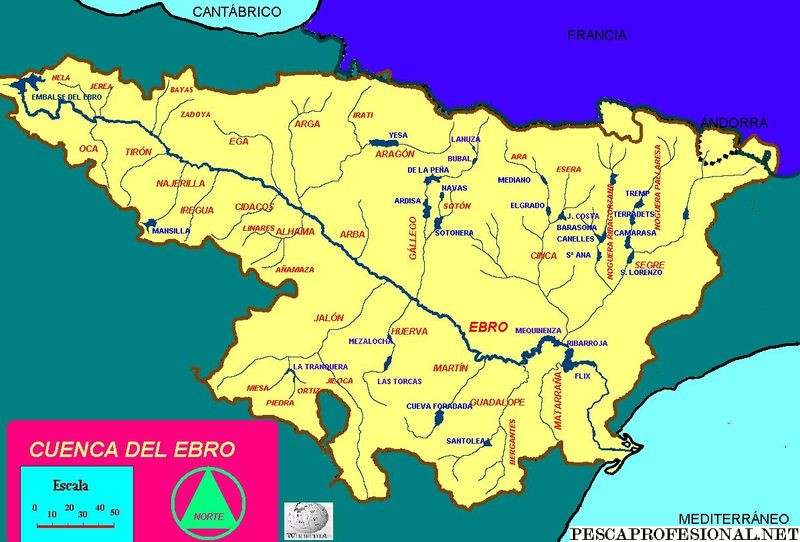
The River Ebro is one of the largest river systems in Spain and is a significant source of hydroelectric power and irrigation, home to a huge head of monster catfish; it is also responsible for making fishermen's dreams come true.
The Ebro runs 565 miles from the Cantabria Mountains in the North, through the Pyrenees and Iberian Mountains and into the Balearic Sea of the Mediterranean between Valencia and Barcelona. It was once a modest rive until a series of dams were built which led to parts of the Ebro valley being flooded to form one of Europe's finest fisheries.
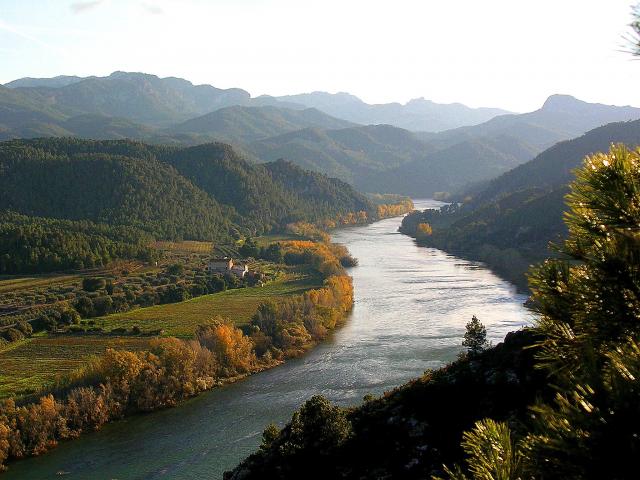
The Wels Catfish, also known as the "European Maneater," is one of the ugliest fish you will ever meet. Although they will not likely swallow you whole, they have the appearance of being able to do so, with wide, bulbous heads and horrible, gaping mouths. The Wels is the only catfish in Spain and grows so large due to having an endless food source of smaller fish and no natural predators. This is what the anglers seek in the River Ebro.
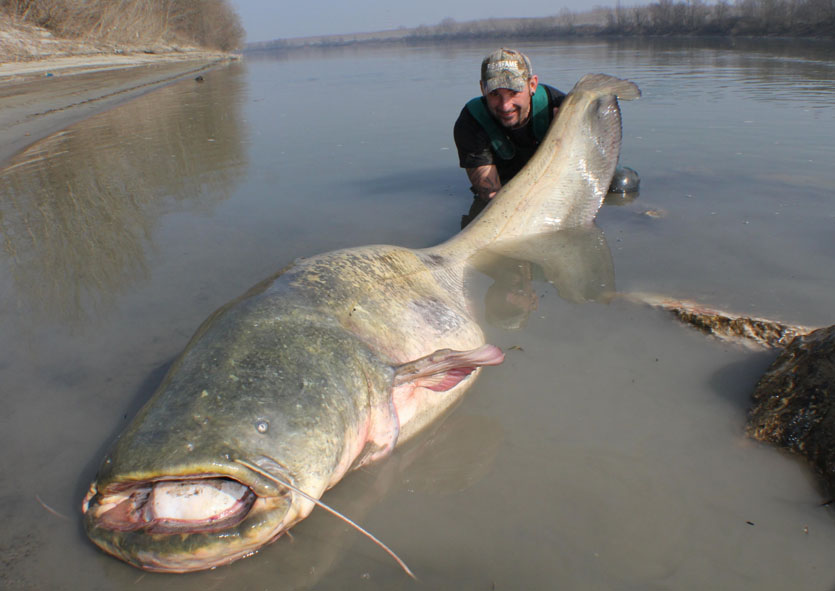
Also called the sheatfish, is a large catfish native to wide areas of central, southern, and eastern Europe, and near the Baltic and Caspian Seas. It has been introduced to Western Europe and is now found from the United Kingdom all the way east to Kazakhstan and south to Greece. It is a scaleless fresh and brackish water fish recognizable by its broad, flat head and wide mouth. Wels catfish can live for at least thirty years and have very good hearing.
This catfish lives on annelid worms, gastropods, insects, crustaceans, and fish including other catfishes; the 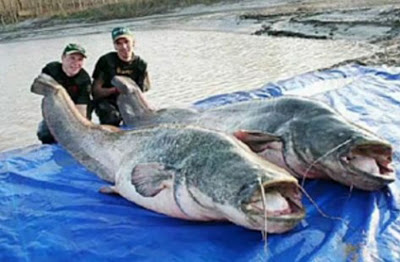 larger ones also eat frogs, mice, rats, and aquatic birds such as ducks. Recently, individuals of this species in environments that are not their native habitats have been observed lunging out of the water to grab pigeons on land.
larger ones also eat frogs, mice, rats, and aquatic birds such as ducks. Recently, individuals of this species in environments that are not their native habitats have been observed lunging out of the water to grab pigeons on land.
The wels lives in large, warm lakes and deep, slow-flowing rivers. It prefers to remain in sheltered locations such as holes in the riverbed, sunken trees, etc. It consumes its food in the open water or in the deep, where it can be recognised by its large mouth which
contains lines of numerous small teeth, two long barbels on the upper jaw and four shorter barbels on the lower jaw. It has a long anal fin that extends to the caudal fin, and a small sharp dorsal fin positioned relatively far forward. It uses its sharp pectoral fins to capture prey. With these fins, it creates an eddy to disorient its victim, which it then simply engulfs in its enormous throat. It has very slippery green-brown skin. Its belly is pale yellow or white. Colour varies with environment. Clear water will give the fish a black colouration while muddy water will often tend to produce brownish specimens. Weight and length are not correlated linearly and also depend on the season.
The female produces up to 30,000 eggs per kilogram of body weight. The male guards the nest until the brood hatches, which, depending on water temperature, can take from three to ten days. If the water level decreases too much or too fast the male has been observed to splash the eggs with its muscular tail in order 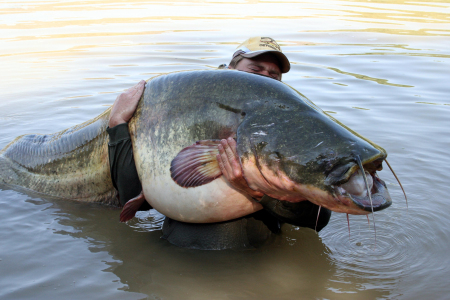 to keep them wet.
to keep them wet.
With a possible total length up to 4 m (13 ft) and a maximum weight of over 180 kg (400 lb), it is the second-largest freshwater fish in its region after the beluga sturgeon. However, such lengths are extremely rare and could not be proved during the last century, but there is a somewhat credible report from the 19th century of a wels catfish of this size.
Most wels catfish are only about 1.3–1.6 m (4 ft 3 in–5 ft 3 in) long; fish longer than 2 m (6 ft 7 in) are normally extremely rare. At 1.5 m (4 ft 11 in) they can weigh 15–20 kg (33–44 lb) and at 2.2 m (7 ft 3 in) they can weigh 65 kg (143 lb).
Only under exceptionally good living circumstances can the wels catfish reach lengths of more than 2 m (6 ft 7 in) which is becoming a regular catch on the River Ebro nowadays. However, on average, a catfish in the River Ebro weighs in at around 100 lbs. People fishing on the river for carp are quite surprised when their rod suddenly doubles over and they discover they have hooked a Wels. These fish are very powerful and difficult to land. They fight hard while in the water, and because they are so slippery, they are not easy to handle.
You need a fishing license to fish anywhere in Spain even if you are on a charter boat, and it is only valid for a specific region. If you intend to fish in various regions, you will need a license for each region. You can obtain the license from the regional office of the Ministry of the Environment (Ministerio de Medio Ambiente). Wels catfish are in fact considered an invasive species and thus you are not supposed to return them to the river, however this is very controversial among anglers and the vast majority are returned. But be aware it is against the law. That said, if you landed a 6ft specimen I don't think the local police would insist on you taking it home!
The Chiprana section of the River Ebro is noted for producing some of the best Wels catfish in the world. It is the location for the World Catfish Classic tournament, a catch and release event (contrary to what the law stipulates). It is a showcase for the best international catfish anglers to demonstrate their best practices. The safety and welfare of the monster fish are taken into consideration during this type of sports event. Winners receive cash prizes for daily and overall records during the four-day event. If you are interested in fishing for Wels catfish there are many guided fishing trips available along the Ebro river run by British and Spanish anglers, in fact, several British anglers hold records for landing the largest specimens.